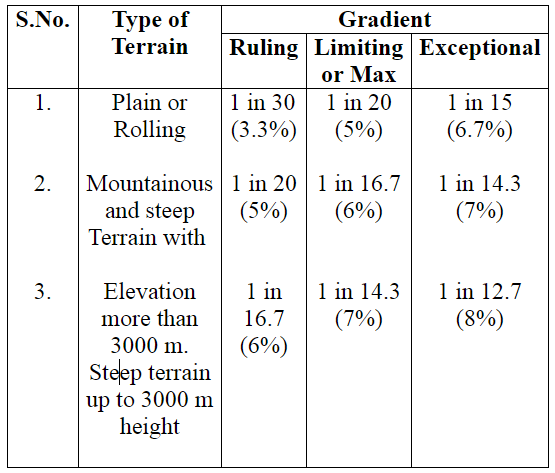Table of Contents
What is Road Gradient?
It is the rate of rise or fall of road level along its length. It is expressed either as the rate of rise or fall to the horizontal distance or as percentage rise or fall.
In India usually, former practice is used. The gradient of pavement is governed by the following factors :
- Characteristics of traffic.
- Physical factors of the site such as drainage, safety, appearance, access to adjacent property.
- Bridge, approach road and railway, line-intersection etc.
Type of Gradient
- Maximum Gradient
- Ruling Gradient
- Limiting Gradient
- Exceptional Gradient
Maximum Gradient
It is the maximum or steepest gradient which is allowed to be provided in a road which must never exceed in any part of the road as steeper gradients are very inconvenient to the traffic, more especially for the slow-moving traffic.
The maximum gradient is allowed to be provided when compelled by the topography of the area to affect a large reduction in the cost of earthwork. Long stretches of such gradient should be separated comparatively flatter gradient or a level section. Thus it is also called a limiting gradient. IRC has recommended the following values of the maximum gradient:
In Flat or Rolling Terrain – 1 in 20
Hilly Terrain – 1 in 15
Ruling Gradient
This is the desirable upper limit or permissible limit of the gradient in the alignment of the road. This is governed by the mode of transport in the locality. Thus a design engineer must aim to provide a gradient within the ruling gradient limits keeping in view the mode of traffic and topography.
This gradient should be such that animal-driven vehicles can overcome long stretches without much fatigue of animals and power-driven vehicles without uneconomical fuel consumption. Indian Road Congress has suggested the value of ruling gradients as below.
In Flat or Rolling Terrain – 1 in 30
Hilly Terrain – 1 in 20
Minimum Gradient
The gradient provided on flat or level road to drain off the rainwater is called minimum gradient. It should be sufficient to drain off the rainwater from the pavement surface. Its value depends upon the topography, type of soil, run-off and other sites conditions.
In general 1 in 200 gradients is sufficient but for cement concrete surface a grade of 1 in 500 is quite sufficient. The 0.5% value may be reduced to 0.30 % for a good quality surface supported on a firm and accurately crowned subgrade.
Exceptional gradient
During the alignment of the road, there may be situations where grades may have to be provided with either lesser than the minimum or greater than the maximum.
Thus exceptional gradients are provided in exceptional situations such as in approaches to causeways or near hairpin bends etc. this gradient should be provided only for very short stretches not exceeding 60 to 100 meters in one-kilometre length and should be separated by a minimum length of 100 m.
Disadvantages of Exceptional Gradients
- More Fuel consumption
- More friction losses
- The efficiency of the engine reduces
- Early fatigue to animals
- More wear and tear to the pavement surface and vehicle too.
The maximum, ruling and exceptional gradients as recommended by Indian Road Congress

Thanks for reading this article. If you find this article helpful, please don’t forget to share it.
Also, read
What is WBM Road? Construction Procedure, Advantages, Disadvantages.
Material Required for Construction of WBM Road
Advantages And Disadvantages of Tunnels